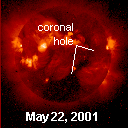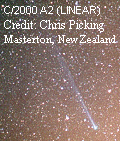|   SPACE WEATHER SPACE WEATHER
Current
Conditions
Solar Wind
velocity: 313.4 km/s
density:17.3 protons/cm3
explanation | more data
Updated: Today at 2245 UT
X-ray Solar Flares
6-hr max: C1 2245 UT May22
24-hr: C1 2245 UT May22
explanation | more data
Updated: Today at 2245 UT
Daily Sun: 22 May '01 
Sunspot 9463 is still growing. It now has a beta-gamma magnetic field that harbors energy for isolated M-class solar flares. Image credit: SOHO/MDI
The Far Side of the Sun
This holographic image reveals no substantial spots on the far side of the Sun. Image credit: SOHO/MDI
Sunspot Number: 118
More about sunspots
Updated: 21 May 2001
Radio Meteor Rate
24 hr max: 23 per hr
Listen to the Meteor Radar!
Updated: 21 May 2001 Interplanetary Mag. Field
Btotal: 10.1 nT
Bz: 5.7 nT south
explanation | more data
Updated: Today at 2246 UT Coronal Holes:

A solar wind gust from the indicated coronal hole could arrive today. Image credit: Yohkoh Soft X-ray Telescope.
More about coronal holes
 SPACE WEATHER SPACE WEATHER
NOAA
Forecasts
Solar Flares: Probabilities for a medium-sized (M-class) or a major (X-class) solar flare during the next 24/48 hours are tabulated below.
Updated at 2001 May 22 2200 UT
| FLARE | 24 hr | 48 hr | | CLASS M | 30 % | 30 % | | CLASS X | 05 % | 05 % |
Geomagnetic Storms: Probabilities for significant disturbances in Earth's magnetic field are given for three activity levels: active, minor storm, severe storm
Updated at 2001 May 22 2200 UT Mid-latitudes | 24 hr | 48 hr | | ACTIVE | 30 % | 30 % | | MINOR | 15 % | 15 % | | SEVERE | 05 % | 05 % |
High latitudes | 24 hr | 48 hr | | ACTIVE | 40 % | 40 % | | MINOR | 20 % | 20 % | | SEVERE | 05 % | 05 % |

Web server provided by
VPS Hosting
| What's Up in Space -- 22 May 2001
Subscribe to Space Weather News! SOLAR ACTIVITY: Solar activity remains low but that could change. The rapidly growing sunspot 9463 has developed a twisted magnetic field that likely harbors energy for M-class flares. Eruptions in the coming days could be Earth-directed as the spot crosses the middle of the Sun.  CRUMBLING COMET: Comet C/2000 A2 (LINEAR) is falling apart! The ESO's Very Large Telescope in Chile revealed on May 18th that the comet's icy core contained at least three "mini-comets" -- continuing a general disintegration that began in late April. This is a naked eye object for southern hemisphere sky watchers, but just barely. At visual magnitude 5.5, the comet is best viewed through binoculars [finder chart]. CRUMBLING COMET: Comet C/2000 A2 (LINEAR) is falling apart! The ESO's Very Large Telescope in Chile revealed on May 18th that the comet's icy core contained at least three "mini-comets" -- continuing a general disintegration that began in late April. This is a naked eye object for southern hemisphere sky watchers, but just barely. At visual magnitude 5.5, the comet is best viewed through binoculars [finder chart].
Above: Chris Picking captured this image of comet LINEAR's six degree-long tail on May 13th using a 35mm camera, 135mm lens, 10 minutes exposure, and Kodak Supra 400 film. The comet's appearance is changing as volatile ices in the fragmenting nucleus are newly exposed to solar radiation. No one knows how much brighter C/2000 A2 will become between now and May 24th, when it will experience a 0.78 AU close encounter with the Sun. See: [3D orbit][ephemeris] WEB LINKS: NOAA FORECAST | GLOSSARY | SPACE WEATHER TUTORIAL | LESSON PLANS | BECOME A SUBSCRIBER | 
Potentially Hazardous Asteroids (PHAs) are space rocks larger than approximately 100m that can come closer to Earth than 0.05 AU. None of the known PHAs are on a collision course with our planet, although astronomers are finding new ones all the time. [more]
On 22 May 2001 there were 309 known Potentially
Hazardous Asteroids May 2001 Earth-asteroid encounters | ASTEROID | DATE (UT) | MISS DISTANCE | | 2001 GQ2 | 2001-Apr-27 12:00 | 7.7 LD | | 2001 FE90 | 2001-May-06 23:37 | 49.7 LD | | 1999 KW4 | 2001-May-25 23:31 | 12.6 LD | Note: LD is a "Lunar Distance." 1 LD = 384,401 km, the distance between Earth and the Moon 
- TOTAL LUNAR ECLIPSE: On Jan. 9, 2001, the full Moon glided through Earth's copper-colored shadow. [gallery]
- CHRISTMAS ECLIPSE: Sky watchers across North America enjoyed a partial solar eclipse on Christmas Day 2000 [gallery]
- LEONIDS 2000: Observers around the globe enjoyed three predicted episodes of shooting stars. [gallery]
 Feb. 21, 2001: Nature's Tiniest Space Junk -- Using an experimental radar at the Marshall Space Flight Center, scientists are monitoring tiny but hazardous meteoroids that swarm around our planet. Feb. 15, 2001: The Sun Does a Flip -- NASA scientists who monitor the Sun say our star's enormous magnetic field is reversing -- a sure sign that solar maximum is here. Jan. 25, 2001: Earth's Invisible Magnetic Tail -- NASA's IMAGE spacecraft, the first to enjoy a global view of the magnetosphere, spotted a curious plasma tail pointing from Earth toward the Sun. Jan. 4, 2001: Earth at Perihelion -- On January 4, 2001, our planet made its annual closest approach to the Sun. Dec. 29, 2000: Millennium Meteors -- North Americans will have a front-row seat for a brief but powerful meteor shower on January 3, 2001. Dec. 28, 2000: Galileo Looks for Auroras on Ganymede -- NASA's durable Galileo spacecraft flew above the solar system's largest moon this morning in search of extraterrestrial "Northern Lights" Dec. 22, 2000: Watching the Angry Sun -- Solar physicists are enjoying their best-ever look at a Solar Maximum thanks to NOAA and NASA satellites. MORE SPACE WEATHER HEADLINES |

